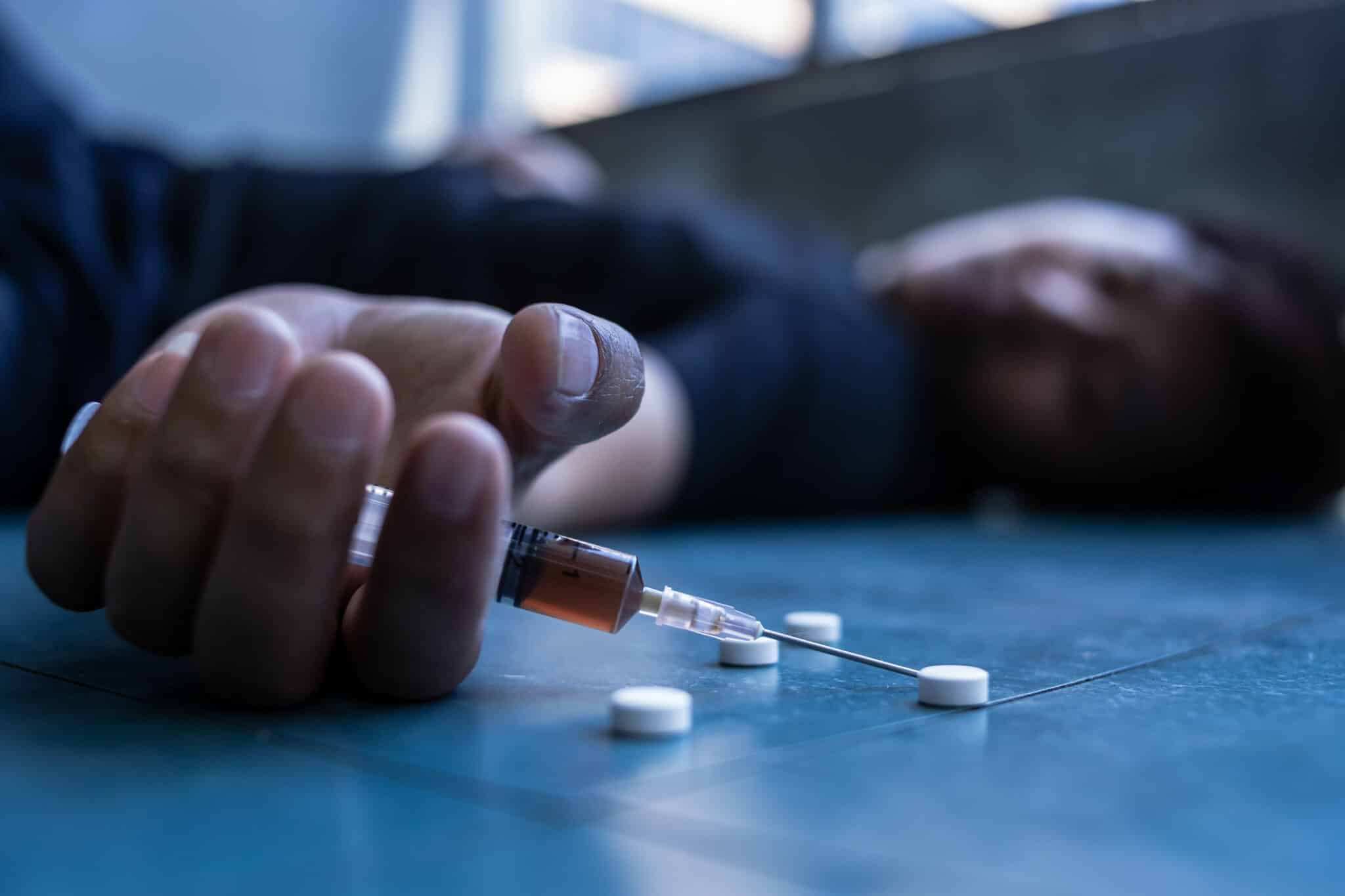
What are some of the behavioral symptoms of heroin addiction?
Behavioral red flags of heroin addiction include:
- Cravings and preoccupation with obtaining more heroin
- Changes in social groups towards other users
- Declining performance at work or school
- Secrecy about activities and possessions like drug paraphernalia
- Escalating legal or financial problems stemming from uncontrolled heroin use despite the extreme adverse effects
What medical conditions can result from heroin use disorder?
Some of the medical conditions tied to ongoing heroin abuse are:
- Heart infections such as endocarditis
- Liver disease from processing toxins
- Vascular issues including blood clots or collapse
- Kidney infections and disease
- Pneumonia and other lung problems
- Mental illnesses
- Suicidal thoughts
- Early risk of death by overdose
What substances does heroin interact dangerously with?
Heroin interacts dangerously with other central nervous system depressants such as alcohol, benzodiazepines, and some sleep medications. Together, these substances compound respiratory depression, leading to coma or fatal overdose. Concurrent stimulant use stresses the cardiovascular system further increasing strain on the heart. Needle sharing spreads infectious diseases rapidly, so intravenous heroin use alongside injection drugs like meth brings added risks.
What are some signs of a heroin overdose?
Some of the telltale signs of a heroin overdose include:
- Extremely pale, cold skin
- Very slow shallow breathing or choking
- A limp body
- Unusually constricted pinpoint pupils
- Bluish skin, nails, feet, or fingertips that indicate oxygen loss
- Confusion
- Extreme drowsiness
- Loss of consciousness
- Abnormally low blood pressure
- Oversedation that precedes coma or death
What medications help treat heroin addiction?
FDA-approved medications for opioid addiction and withdrawal management include the opioid agonists methadone and buprenorphine, which activate receptors, easing cravings and symptoms, and blocking other opioids. Naltrexone is an antagonist that blocks any opioid effect. Clonidine, an alpha agonist, reduces some withdrawal side effects. Medications can be coupled with individual or group therapy for whole health recovery.
What are some risk factors that could lead to heroin addiction?
Major risk factors for heroin addiction include:
- Early traumatic exposures
- Family history of substance abuse
- Concurrent untreated mental illness
- Initial prescription opioid misuse
- Certain genetic variants affecting impulse control
- History of conduct disorder
- Poor academic and occupational performance
- Unemployment
- Financial insecurity
- Social environmental factors
What happens to the brain and body during heroin withdrawal?
Heroin withdrawal sparks an intense multisystem reaction as suppressed processes such as digestion and blood pressure regain function. This is coupled with brain chemical imbalances triggering psychological and physical symptoms like bone pain, nausea, anxiety, and intense cravings.
Withdrawal may provoke self-harm without support. Buprenorphine manages symptoms by safely occupying opioid receptors, while medical supervision provides fluids, medications, and nutrition, and monitors potentially life-threatening complications.
Why do many people struggle with relapse after quitting heroin?
Even after overcoming painful acute withdrawal during detox, protracted symptoms like cravings, concentration lapses, low motivation, or mood may persist for weeks or months as the brain gradually rebalances. Without aftercare support, these residual symptoms coupled with memories and environmental triggers elevate relapse risk. Psychotherapy and peer communities foster new coping strategies and lifestyle changes needed for longevity in recovery by rewarding sobriety milestones and managing related health conditions.
What is heroin?
Heroin is an illegal, highly addictive opioid drug synthesized from morphine, which comes from the opium poppy plant. It can be a white or brown powder or a black sticky substance known as black tar heroin. When injected, snorted, or inhaled, heroin quickly binds to the brain’s opioid receptors, giving that euphoric, sedative, and extremely addictive high.
Addiction can develop quickly but often after a stretch of regular use. Because of heroin’s intense habit-forming nature, it is considered one of the most dangerous and deadliest drugs out there.
Resources
NIDA. 2021, April 13. What are the long-term effects of heroin use? Retrieved from https://nida.nih.gov/publications/research-reports/heroin/what-are-long-term-effects-heroin-use on 2024, February 13
Mahboub, N., Rizk, R., & Karavetian, M. (2021). Nutritional status and eating habits of people who use drugs and/or are undergoing treatment for recovery: A narrative review. Nutrition Reviews, 79(6), 627-635. https://doi.org/10.1093/nutrit/nuaa095
Johnson SW, North RA. Opioids excite dopamine neurons by hyperpolarization of local interneurons. J Neurosci. 1992 Feb;12(2):483-8. doi: 10.1523/JNEUROSCI.12-02-00483.1992. PMID: 1346804; PMCID: PMC6575608.
Kosten, T. R., & George, T. P. (2002). The Neurobiology of Opioid Dependence: Implications for Treatment. Science & Practice Perspectives, 1(1), 13-20. https://doi.org/10.1151/spp021113
Wang X, Li B, Zhou X, Liao Y, Tang J, Liu T, Hu D, Hao W. Changes in brain gray matter in abstinent heroin addicts. Drug Alcohol Depend. 2012 Dec 1;126(3):304-8. doi: 10.1016/j.drugalcdep.2012.05.030. Epub 2012 Jun 18. PMID: 22717339.
Mavrikaki, M. (2020, June 26). Brain plasticity in drug addiction: Burden and benefit. Harvard Health. https://www.health.harvard.edu/blog/brain-plasticity-in-drug-addiction-burden-and-benefit-2020062620479
Ghuran, A., & Nolan, J. (2001). Cardiovascular complications of recreational drugs: Are an important cause of morbidity and mortality. BMJ: British Medical Journal, 323(7311), 464-466. https://doi.org/10.1136/bmj.323.7311.464
Rubio G, Alguacil LF, Alamo C, Pascual J, Lopez-Trabada JR. Relapse to opiate use provokes biphasic changes of blood pressure in heroin-withdrawn addicts treated with clonidine. Drug Alcohol Depend. 1992 Jun;30(2):193-8. doi: 10.1016/0376-8716(92)90026-9. PMID: 1321712.
Karoli, R., Fatima, J., Singh, P., & Kazmi, K. I. (2012). Acute myocardial involvement after heroin inhalation. Journal of Pharmacology & Pharmacotherapeutics, 3(3), 282-284. https://doi.org/10.4103/0976-500X.99448
Ji, Y., Kujtan, L., & Kershner, D. (2012). Acute endocarditis in intravenous drug users: A case report and literature review. Journal of Community Hospital Internal Medicine Perspectives, 2(1). https://doi.org/10.3402/jchimp.v2i1.11513
Jolley, C. J., Bell, J., Rafferty, G. F., Moxham, J., & Strang, J. (2015). Understanding Heroin Overdose: A Study of the Acute Respiratory Depressant Effects of Injected Pharmaceutical Heroin. PLoS ONE, 10(10). https://doi.org/10.1371/journal.pone.0140995
Farkas A, Lynch MJ, Westover R, Giles J, Siripong N, Nalatwad A, Pizon AF, Martin-Gill C. Pulmonary Complications of Opioid Overdose Treated With Naloxone. Ann Emerg Med. 2020 Jan;75(1):39-48. doi: 10.1016/j.annemergmed.2019.04.006. Epub 2019 Jun 8. PMID: 31182316.
Baldo BA. Toxicities of opioid analgesics: respiratory depression, histamine release, hemodynamic changes, hypersensitivity, serotonin toxicity. Arch Toxicol. 2021 Aug;95(8):2627-2642. doi: 10.1007/s00204-021-03068-2. Epub 2021 May 11. PMID: 33974096.
Ilić, G., Karadžić, R., Kostić-Banović, L., Stojanović, J., & Antović, A. (2010). ULTRASTRUCTURAL CHANGES IN THE LIVER OF INTRAVENOUS HEROIN
ADDICTS. Bosnian Journal of Basic Medical Sciences, 10(1), 38-43. https://doi.org/10.17305/bjbms.2010.2730
Singh, V. P., Singh, N., & Jaggi, A. S. (2013). A Review on Renal Toxicity Profile of Common Abusive Drugs. The Korean Journal of Physiology & Pharmacology: Official Journal of the Korean Physiological Society and the Korean Society of Pharmacology, 17(4), 347-357. https://doi.org/10.4196/kjpp.2013.17.4.347
Márquez-Grant, N., Baldini, E., Jeynes, V., Biehler-Gomez, L., Aoukhiyad, L., Passalacqua, N. V., Giordano, G., Candia, D. D., & Cattaneo, C. (2022). How Do Drugs Affect the Skeleton? Implications for Forensic Anthropology. Biology, 11(4). https://doi.org/10.3390/biology11040524
Galassi, G., Ariatti, A., Gozzi, M., & Cavazza, S. (2013). A heroin addict with focal weakness. Acta Myologica, 32(1), 27-29. https://www.ncbi.nlm.nih.gov/pmc/articles/PMC3665371/
Nazmara Z, Najafi M, Rezaei-Mojaz S, Movahedin M, Zandiyeh Z, Shirinbayan P, Roshanpajouh M, Asgari HR, Hosseini Jafari Lavasani L, Koruji M. The Effect of Heroin Addiction on Human Sperm Parameters, Histone-to-Protamine Transition, and Serum Sexual Hormones Levels. Urol J. 2019 Jun 17;16(3):289-294. doi: 10.22037/uj.v0i0.4321. PMID: 30206922.
NIDA. 2021, April 13. How does heroin use affect pregnant women?. Retrieved from https://nida.nih.gov/publications/research-reports/heroin/how-does-heroin-abuse-affect-pregnant-women on 2024, February 13
NIDA. 2022, September 27. Part 1: The Connection Between Substance Use Disorders and Mental Illness. Retrieved from https://nida.nih.gov/publications/research-reports/common-comorbidities-substance-use-disorders/part-1-connection-between-substance-use-disorders-mental-illness on 2024, February 13
Gould, T. J. (2010). Addiction and Cognition. Addiction Science & Clinical Practice, 5(2), 4-14. https://www.ncbi.nlm.nih.gov/pmc/articles/PMC3120118/
Further reading
What is drug addiction treatment like?
What are the types of illegal drugs?
What drugs damage the kidneys the most?
What drug causes the most damage to the body?
What is the best way to detox?
How to prevent drug abuse in teens





